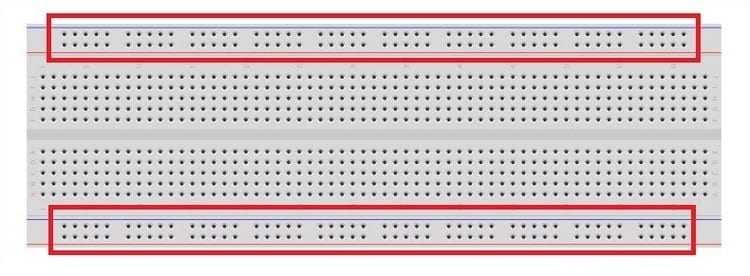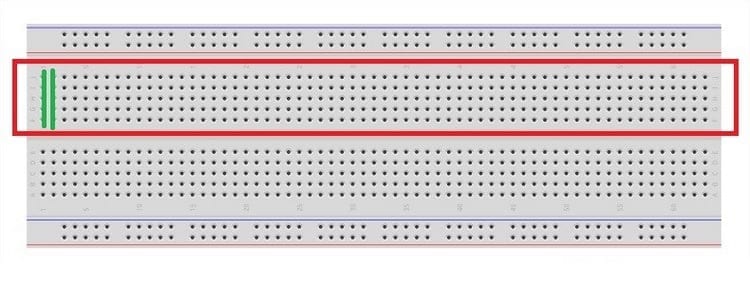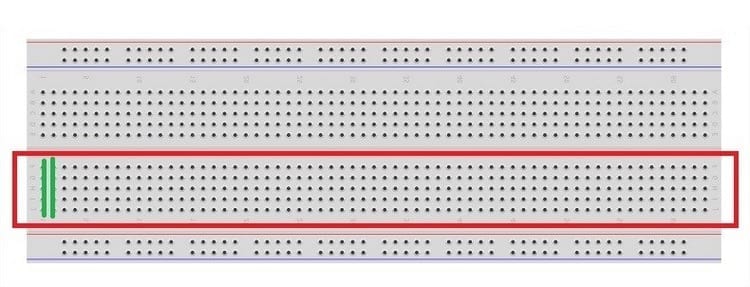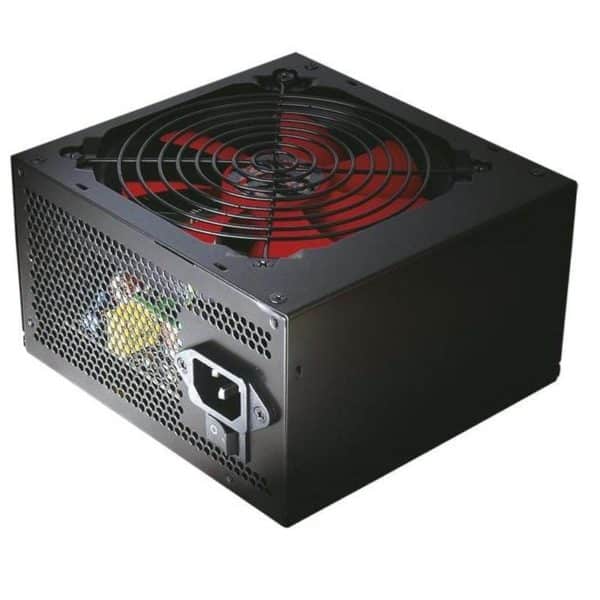If you like electronics, it is very important that you start learning what is a breadboard, in addition to the fact that it is important to know its uses, the different types of breadboards that we have on the market, the parts into which it is divided, and of course we are also going to give you some very simple tips when it comes to buy a breadboard.

Article Content
What is a breadboard
Breadboard is the English name of the insert plate o breadboard, which is basically a small board that includes various holes that follow a certain pattern, which, internally, are electrically connected to each other.
Basically it is the element that you can see in the image, with the particularity that inside it there are these connections that are not visible from the outside.
To give you an idea, it is mainly made up of two materials that are an insulator, which in most cases will be a plastic, and a conductive material, which is what is found inside and connects the different holes between they.
What is the breadboard for?
Basically, the objective of the breadboard is to allow us to insert all types of electronic components and cables, thus managing to assemble an electronic circuit or a system for different uses.
Thanks to this small board, we will be able to create and test all types of electronic circuit prototypes, something essential in the first place to practice, that is, if you are learning electronics you will need a breadboard to learn, and of course it is also about of the model that we are going to create before mechanically printing the circuit in commercial production systems.
If we had to create circuits without first being able to recreate the model to check that everything works correctly, the costs would be immense, plus we would obviously be talking about a considerable complication when making all the adjustments.
In this way, thanks to the breadboard we will be able to go from learning electronics to creating circuits professionally to ensure that they function correctly before printing.
Breadboard Types
It is important to keep in mind that we are going to have two main types of breadboard at our disposal, which are the following:
- Perfboard: This is a perforated plate in which each hole is surrounded by conductive material, which will generally be copper. However, in this case they are not interconnected with each other, in addition, each component must be soldered to the board and the connections between them are carried out through cables or solder paths.
- Stripboard: it would be the same type of plate as in the previous case, but this time the holes would be interconnected with each other.
It is also important to keep in mind that there are different types of breadboard depending on the size and number of holes it has, a detail that we must take into account when purchasing the model that best suits the project we have in hand. , or even to the learning process.
How it is used
In this video they explain the steps you must follow to start using it:
Know the parts of the breadboard
Mainly we are going to distinguish three parts in one breadboard plate, which are the feeding area, the upper connection area, and the lower connection area.
The feeding area

A breadboard has two power zones, which are located at the top and bottom of the board.
Here we can see two horizontal lines of holes that are electrically connected to each other.
One of the lines is intended for food, while the other is for dough.
The upper connection area

On the other hand, we have the upper connection area, which is the one we have marked in the image.
In this sense, it is very important to keep in mind that the holes are electrically connected to each other, but only by columns, so that each vertical column is electrically independent of the others.
The lower connection area

We also have the lower connection area which is basically the same as the upper one.
It should be noted that the upper zone and the lower zone are electrically separated.
In any case, this lower area is essential if we want to create integrated circuits that include two rows of pins.
In addition to taking these three areas into account, it is important to know that each hole is numbered, so that the rows will be identified by a letter, while the columns are identified with numbers, something essential to be able to organize ourselves well, especially when it comes to complicated projects.
Tips when buying a board
Of course, in the market we will have the possibility of choosing between a wide range of breadboards, although basically the pieces will be the same but, yes, we will have alternatives that will allow us, for example, to acquire several boards for one price. cheaper, or there are even some that include all the necessary components to create our own prototypes, being the ideal option for those of you who do not yet have much experience and need something complete that allows you to advance little by little without having to buy everything. the components separately.
Here we are going to leave you some of the alternatives that we consider the most interesting, which come at a truly affordable price, and include everything you need to carry out your first projects or even advanced projects.
Industrial Engineering student and lover of writing and technology, for several years I have participated in various pages with the aim of always keeping myself informed of the latest trends and contributing my grain of sand in this immense dissemination network that we know as the Internet.




